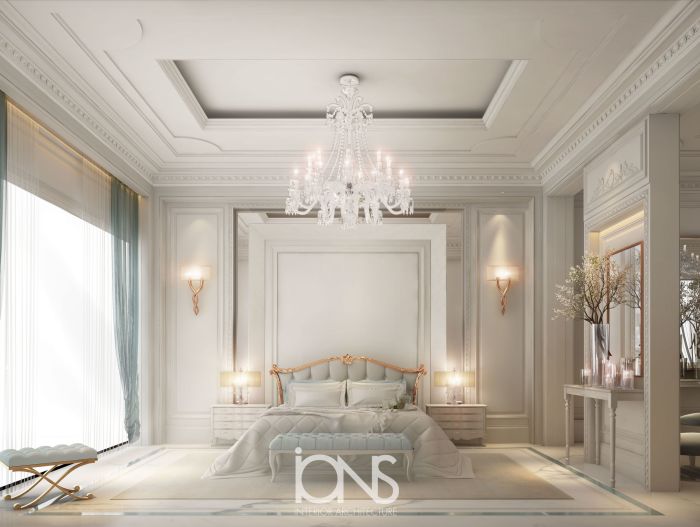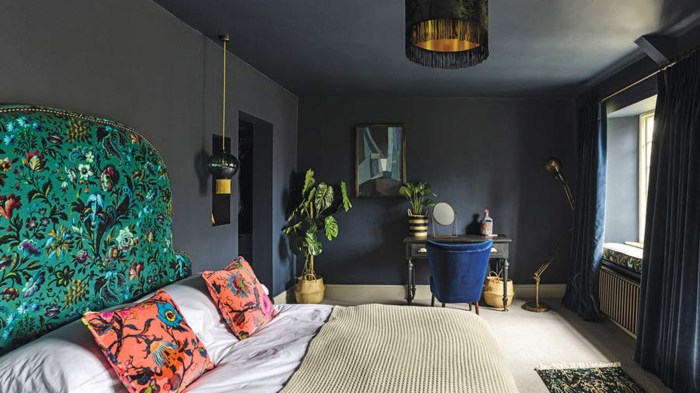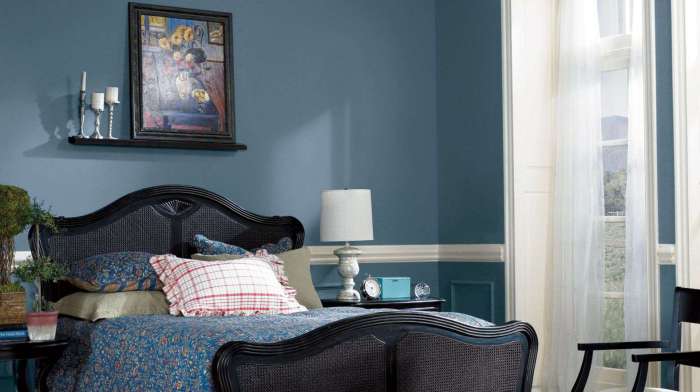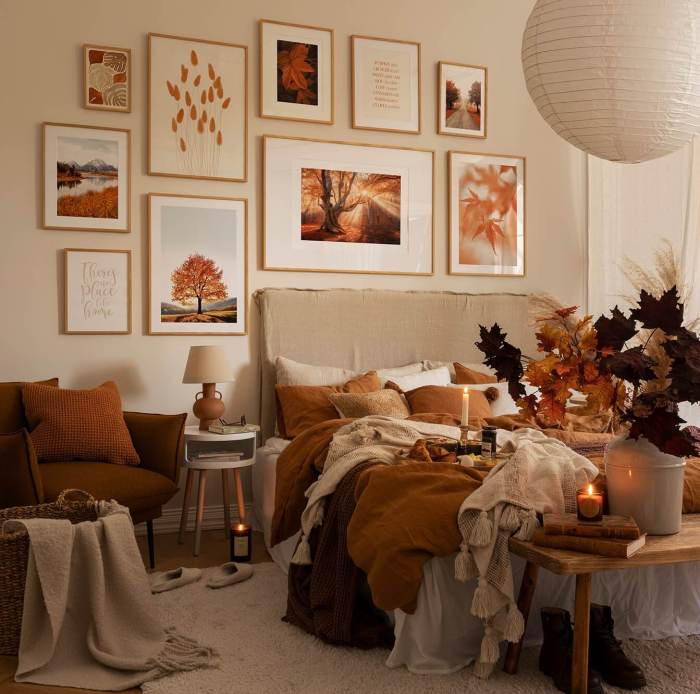Designing a warm-toned classic bedroom involves a harmonious blend of color palettes, furniture choices, lighting strategies, and textile selections. The goal is to create a sanctuary that exudes tranquility and timeless elegance. This exploration delves into the scientific principles of color psychology and light interaction to guide you through the process of crafting a space that is both aesthetically pleasing and functionally optimized for rest and relaxation.
We will examine how different hues impact mood, how furniture placement affects spatial flow, and how lighting choices influence the overall ambiance, drawing upon established design principles and incorporating practical examples.
The journey begins with exploring carefully curated color palettes, each with its unique mood and suitability for various lighting conditions. We then transition to furniture selection, emphasizing the importance of both form and function within the classic aesthetic. The role of lighting, encompassing ambient, task, and accent lighting, is meticulously analyzed to demonstrate how to cultivate a warm and inviting atmosphere.
Finally, we’ll delve into the crucial aspects of textiles and decorative elements, showcasing how texture, pattern, and strategically placed accessories contribute to the overall design harmony. The principles discussed are illustrated with detailed examples, including floor plans and mood boards, ensuring a practical and comprehensive understanding of the design process.
Color Palettes for Warm-toned Classic Bedrooms

Warm-toned classic bedrooms evoke feelings of comfort, relaxation, and timeless elegance. The careful selection of a color palette is paramount in achieving this ambiance. The psychology of color significantly impacts our mood and perception of space, and warm tones, with their inherent inviting qualities, are particularly well-suited for the bedroom environment. Understanding the interplay of hue, saturation, and value allows for the creation of diverse and captivating palettes.
Warm Classic Palette 1: Sun-Kissed Serenity
This palette centers around the comforting warmth of natural sunlight, creating a feeling of calm and tranquility. It utilizes a base of soft, muted tones, accented with richer hues for visual interest.
| Color | Hex Code | Application | Notes |
|---|---|---|---|
| Wall Color | #F2E9E4 | Walls | A soft, creamy off-white, providing a neutral backdrop. |
| Bedding | #CDB79E | Sheets, duvet cover | A warm, light beige, promoting a sense of relaxation. |
| Accent Color | #A0522D | Throw pillows, artwork | A rich, earthy brown adds depth and visual interest. |
Warm Classic Palette 2: Rustic Rose Embrace
This palette evokes a sense of romantic charm and warmth, utilizing a blend of rosy hues and muted neutrals. The color psychology suggests feelings of comfort and gentle energy.
| Color | Hex Code | Application | Notes |
|---|---|---|---|
| Wall Color | #F0D9D1 | Walls | A soft blush pink, creating a romantic and inviting atmosphere. |
| Bedding | #D2B48C | Sheets, duvet cover | A warm taupe provides a neutral counterpoint to the pink walls. |
| Accent Color | #8B4513 | Throw pillows, furniture | A deep saddle brown adds richness and sophistication. |
Warm Classic Palette 3: Golden Hour Glow
This palette captures the warm, golden light of sunset, creating a luxurious and sophisticated feel. The use of gold accents adds a touch of opulence.
| Color | Hex Code | Application | Notes |
|---|---|---|---|
| Wall Color | #E6B8AF | Walls | A soft apricot, creating a warm and inviting atmosphere. |
| Bedding | #DAA520 | Accent pillows, throws | A golden yellow adds a touch of luxury and warmth. |
| Accent Color | #800000 | Furniture, artwork | A deep maroon adds depth and sophistication. |
Furniture Selection and Placement
The harmonious integration of furniture within a warm-toned classic bedroom hinges on careful selection and strategic placement. Classic design emphasizes timeless elegance and functionality, relying on enduring forms and high-quality materials. Choosing pieces that complement the warm color palette is crucial for creating a cohesive and inviting atmosphere. Optimal placement maximizes space utilization and enhances the room’s aesthetic appeal, transforming it from a mere sleeping space into a sanctuary of comfort and style.The principles of classic furniture design emphasize clean lines, sturdy construction, and high-quality materials.
Woods like cherry, walnut, and mahogany, known for their rich tones, are particularly well-suited to warm-toned palettes. These woods offer a natural warmth that complements earth tones, creams, and muted reds. Upholstery should echo the color scheme, with fabrics such as velvet, linen, or even leather providing texture and visual interest. The furniture’s scale should be proportionate to the room’s size; oversized pieces in a small room will feel overwhelming, while undersized pieces will appear lost.
A balanced approach ensures visual harmony and comfortable functionality.
Classic Bedroom Furniture Characteristics and Selection for Warm Tones
Classic bedroom furniture often features ornate detailing, such as carved legs or inlaid patterns, adding visual richness. However, in a warm-toned bedroom, it’s crucial to balance ornamentation with simplicity. Too much detail can create a cluttered look. Therefore, selecting pieces with subtle detailing, or focusing on the inherent beauty of the wood grain, is a more effective approach. For instance, a simple, elegantly designed headboard in a rich cherry wood can anchor the room without overwhelming the warm tones.
Similarly, a chest of drawers with clean lines and brass hardware can add a touch of sophistication without detracting from the overall warmth. The key is to create a sense of balance and visual flow. The use of natural materials like wood and linen contributes to a sense of calm and tranquility, key elements of a classic, warm bedroom design.
Optimal Furniture Placement for Functionality and Aesthetic Appeal
Functionality and aesthetic appeal are intertwined in classic bedroom design. The bed, as the central feature, should be positioned to maximize natural light and create a focal point. Avoid placing it directly under a window, as this can lead to drafts and overheating. Instead, consider placing it against a wall with a visually appealing backdrop, such as a feature wall or built-in shelving.
Nightstands should flank the bed, providing convenient surfaces for lamps and personal items. A dresser or armoire can be positioned strategically to balance the room’s visual weight, perhaps opposite the bed or in a less prominent area. The placement of a seating area, such as a comfortable armchair or chaise lounge, can further enhance the room’s functionality and invite relaxation.
Proper spacing between furniture pieces is also crucial; adequate circulation space ensures ease of movement and prevents the room from feeling cramped.
Furniture Arrangement Floor Plan for a 12x14ft Bedroom
Consider a 12x14ft bedroom. The bed (6ft x 4ft) is positioned against the longest wall (14ft), centered, leaving approximately 4ft of space on either side. A nightstand (2ft x 2ft) is placed on each side of the bed, leaving a walkway of at least 3ft. A dresser (6ft x 2ft) is positioned on the opposite wall, centered.
An armchair (3ft x 3ft) with a small side table (2ft x 2ft) creates a seating area in the remaining space. This arrangement balances functionality and aesthetics, creating a comfortable and visually appealing layout. The precise dimensions and placement can be adjusted to accommodate individual preferences and the specific furniture chosen. This example demonstrates a balanced arrangement where traffic flow is prioritized, and visual weight is evenly distributed.
The resulting space is both functional and aesthetically pleasing, reflecting the principles of classic design within a warm-toned environment.
Lighting and Ambiance

The careful orchestration of light is paramount in establishing the warm and inviting atmosphere of a classic bedroom. Light, in its various forms and intensities, profoundly impacts our perception of space, influencing mood and even our biological rhythms. Understanding the interplay of different lighting types allows for the creation of a truly restful and luxurious sanctuary.The science of lighting design hinges on the strategic use of three primary types: ambient, task, and accent lighting.
Each contributes uniquely to the overall ambiance, working synergistically to create a layered and nuanced lighting scheme. The correct balance of these elements is crucial in achieving the desired warm, classic aesthetic.
Ambient Lighting: Establishing the Foundation
Ambient lighting provides the overall illumination of the room, setting the foundational mood. In a warm-toned classic bedroom, this is best achieved with warm-white light sources (around 2700-3000 Kelvin), which mimic the soft glow of incandescent bulbs. For example, a large, ornate chandelier, perhaps crafted from antiqued brass or wrought iron with delicately frosted glass shades, could serve as the primary ambient light source.
This central fixture casts a soft, diffused light across the entire space, eliminating harsh shadows and creating a sense of calm. Alternatively, recessed lighting with warm-toned LEDs can provide a more subtle, even distribution of light, ideal for smaller bedrooms or those with lower ceilings.
Task Lighting: Functionality and Focus
Task lighting provides focused illumination for specific activities, such as reading or applying makeup. In a bedroom, this might include bedside lamps, strategically placed to avoid glare. Elegant table lamps with linen shades and brass bases complement the classic style, offering a warm and inviting glow perfect for reading before sleep. The warm light emitted from these lamps reduces eye strain and promotes relaxation.
Consider using dimmable bulbs to adjust the brightness according to individual needs and preferences.
Accent Lighting: Highlighting Architectural Details and Artwork
Accent lighting strategically highlights specific features within the room, adding depth and visual interest. In a classic bedroom, this could involve using wall sconces to illuminate artwork or architectural details like crown molding. Sconces with warm-toned bulbs, such as those with a brushed nickel or antique brass finish, enhance the warmth and sophistication of the space. The subtle glow from these fixtures draws attention to carefully selected pieces, creating visual focal points and adding to the overall richness of the design.
Lighting Design Tips for Enhanced Warmth and Coziness
The strategic application of lighting significantly impacts the overall feeling of warmth and coziness. The following tips can be implemented to optimize the lighting design in a warm-toned classic bedroom:
Careful consideration of light color temperature is key. Warm-toned light sources (2700-3000K) are crucial for creating a cozy and inviting atmosphere. Avoid cool-toned (5000K+) lights, as they can make the space feel sterile and impersonal.
Layering different light sources—ambient, task, and accent—creates a more dynamic and visually appealing space. This layered approach prevents harsh shadows and promotes a sense of depth and comfort.
Dimmers are invaluable tools for adjusting light levels to suit the mood and time of day. Dimming the lights in the evening creates a relaxing atmosphere conducive to sleep.
Consider the placement of light sources carefully to avoid glare and harsh shadows. Proper placement enhances the overall visual appeal and comfort of the space.
Incorporate natural light whenever possible. Maximize the use of natural light during the day to enhance the warmth and brightness of the room, reducing reliance on artificial light sources. Sheer curtains or blinds can help to diffuse strong sunlight while still allowing ample natural light to enter.
Textiles and Fabrics
The selection of textiles plays a crucial role in establishing the ambiance and tactile experience of a warm-toned classic bedroom. The right fabrics can amplify the feeling of comfort, luxury, and timeless elegance, while inappropriate choices can detract from the overall aesthetic. Understanding the properties of different fabrics and their interplay with light and color is paramount to achieving the desired effect.The inherent properties of various textiles, such as their texture, drape, and thermal qualities, significantly impact the perceived warmth of a space.
Natural fibers generally offer superior breathability and a more luxurious feel than synthetics, aligning perfectly with the classic aesthetic. Furthermore, the strategic use of patterns and textures can create visual interest and depth, enhancing the overall sense of warmth and sophistication.
Fabric Types for Warm-Toned Classic Bedrooms
Three fabric types commonly employed in classic bedroom design that excel in warm-toned settings are linen, cotton, and velvet. Linen, a natural fiber known for its breathability and slightly textured surface, provides a relaxed yet sophisticated feel. Its slightly irregular weave adds visual interest, complementing warm color palettes beautifully. Cotton, another natural fiber, offers softness and comfort, making it ideal for bedding.
Its absorbency is beneficial for temperature regulation, especially in warmer climates. Velvet, a luxurious fabric with a deep pile, adds a touch of opulence and warmth through its rich texture and ability to reflect light, creating a sense of depth and richness in the room. Its soft hand feel contributes to the overall sense of comfort and indulgence.
Texture and Pattern Contributions to Warmth and Classic Feel
Different textures and patterns contribute significantly to the overall warmth and classic feel of a warm-toned bedroom. Smooth, luxurious fabrics like velvet or satin create a sense of opulence and refinement, while textured fabrics like linen or wool add visual interest and a more rustic, yet still elegant, feel. Subtle patterns such as stripes, damask, or florals in muted warm tones can add depth and sophistication without overwhelming the space.
The interplay of textures, such as pairing a smooth velvet headboard with textured linen bedding, creates visual harmony and tactile interest. Conversely, overly busy patterns or stark, modern textures can disrupt the classic aesthetic.
Textile Choices for a Warm-Toned Classic Bedroom
The following list provides textile suggestions, categorized by application and including color recommendations, for achieving a warm-toned classic bedroom:
Careful consideration of color and texture is crucial for creating a cohesive and visually appealing design. Warm, earthy tones are generally preferred in a classic warm-toned bedroom setting.
- Bedding: High-thread-count cotton sheets in cream, ivory, or a soft beige. A linen duvet cover in a warm taupe or dusty rose. A wool throw blanket in a deep burgundy or burnt orange for added warmth and texture.
- Curtains: Linen curtains in a warm, golden yellow or a soft terracotta. Alternatively, velvet curtains in a deep emerald green or a rich chocolate brown can add a luxurious touch and enhance light absorption for a cozy atmosphere.
- Throw Pillows: A mix of textures and patterns, such as a velvet pillow in a mustard yellow, a linen pillow in a subtle paisley print in warm browns and creams, and a faux fur pillow in a creamy white for added texture and visual interest.
Decorative Elements and Accessories
The strategic placement of decorative elements in a warm-toned classic bedroom is crucial for achieving a cohesive and visually appealing space. These elements, beyond merely adding aesthetic flair, contribute significantly to the overall mood and functionality of the room, leveraging principles of visual psychology and design theory to enhance the user experience. The careful selection of materials, textures, and styles ensures harmony with the existing color palette and furniture choices, creating a space that is both inviting and sophisticated.The incorporation of decorative elements acts as a powerful tool in directing the eye and establishing focal points within the bedroom.
This is achieved through a nuanced understanding of visual weight, scale, and contrast, drawing upon established design principles to create a balanced and harmonious composition. By strategically positioning mirrors to amplify light and artwork to express personal style, the space transforms from a mere sleeping area into a personalized sanctuary.
Artwork Selection and Placement
Appropriate artwork can significantly enhance the warmth and classic feel of a bedroom. Consider pieces featuring landscapes in muted earth tones, still lifes with rich textures, or abstract paintings with warm color palettes. The size and placement of the artwork are critical. A large piece above the bed acts as a strong focal point, while smaller pieces can be grouped on side tables or dressers to add visual interest.
For instance, a large oil painting depicting a Tuscan sunset would complement a warm-toned room, while smaller framed botanical prints could add detail to a bedside table. The frames themselves should also be considered; heavy, ornate frames in dark wood or gold would reinforce the classic aesthetic, while simpler, lighter frames could provide a more contemporary touch within the overall classic style.
Mirrors and Their Reflective Properties
Mirrors are invaluable tools in bedroom design, not only for their practical use but also for their ability to enhance the perception of space and light. Strategically placed mirrors can visually expand a small room, creating a sense of openness and airiness. A large, ornate mirror above a dresser or vanity reflects light, brightening the room and adding a touch of elegance.
Smaller, decorative mirrors can be used to add visual interest to shelves or side tables. The choice of frame is crucial; a gilded frame contributes to the classic aesthetic, while a more minimalist frame can provide a modern counterpoint. Scientifically, the reflective properties of mirrors are governed by the laws of reflection, where the angle of incidence equals the angle of reflection, maximizing light distribution within the space.
Rugs as Textural Anchors
Rugs serve as both functional and decorative elements in a bedroom, defining areas and adding warmth and texture underfoot. A large rug placed beneath the bed grounds the space and creates a sense of cohesion. The material and color of the rug should complement the overall color scheme; a plush wool rug in a warm neutral tone, such as cream or beige, would enhance the classic feel.
Alternatively, a rug with a subtle pattern or texture can add visual interest without being overwhelming. The texture of the rug contributes significantly to the sensory experience of the room; a soft, high-pile rug offers a luxurious feel underfoot, enhancing the overall comfort and ambiance. The size of the rug should be carefully considered to ensure it complements the size of the room and furniture.
Mood Board: A Visual Representation
Imagine a mood board showcasing a selection of decorative elements. The central element is a large landscape painting depicting a sun-drenched meadow, framed in a dark, ornate wooden frame. The painting’s warm, earthy tones – ochre, burnt sienna, and deep gold – echo the overall color palette of the room. To the side, a smaller, gilded mirror with a subtly distressed finish reflects light and adds a touch of old-world charm.
Below the painting, a large, plush wool rug in a creamy beige anchors the bed area, its texture adding a sense of warmth and luxury. Finally, several smaller decorative elements, such as antique brass candle holders and porcelain vases filled with dried flowers, are scattered around the space, adding subtle layers of texture and visual interest. These elements, carefully chosen and strategically placed, create a harmonious and inviting atmosphere.
The overall style is classic, yet subtly updated with the use of carefully selected textures and materials.
Illustrative Examples

The following sections delve into three distinct styles of warm-toned classic bedrooms, showcasing how different design choices can evoke unique atmospheres and sensory experiences. Each style utilizes the principles of warm color palettes, considered furniture placement, and carefully selected textiles to achieve a cohesive and inviting aesthetic. The impact of lighting and carefully chosen accessories will also be highlighted, demonstrating the crucial role they play in establishing the overall mood and character of the space.
Traditional Warm-Toned Classic Bedroom
The traditional style embraces rich, saturated hues such as deep reds, warm browns, and golden yellows, often found in antique furniture and period textiles. Imagine a room bathed in the warm glow of a sunset, the walls painted in a deep terracotta, complemented by mahogany furniture. A large four-poster bed, draped with heavy velvet curtains in a burgundy hue, commands the center of the room.
The floor is covered in a plush, thick carpet in a deep cream color, providing both warmth and comfort underfoot. The air is thick with the scent of aged wood and polished brass, emanating from the antique dresser and ornate mirror. The overall effect is one of opulent comfort and timeless elegance; a sanctuary that whispers of generations past.
Accessories like antique porcelain vases and framed family portraits add to the sense of history and cherished memories. Layered lighting, from a central chandelier to bedside lamps, creates a warm, inviting glow, further enhancing the room’s comforting ambiance.
Transitional Warm-Toned Classic Bedroom
The transitional style deftly blends traditional elements with contemporary lines and a lighter, more airy feel. Think soft, muted tones – creamy beiges, gentle greys, and warm, honeyed browns – forming the backdrop. Furniture pieces are a mix of traditional styles and sleek modern designs; a classic sleigh bed might be paired with a minimalist nightstand and a contemporary dresser with clean lines.
The textiles are a mix of textures – luxurious linens, soft velvets, and perhaps a subtle patterned rug. Natural light plays a crucial role, highlighting the warm tones and creating a sense of spaciousness. Accessories might include simple, elegant artwork, a few carefully chosen books, and perhaps a decorative bowl filled with natural elements like stones or dried flowers.
The overall feeling is one of refined sophistication, a balance between classic elegance and modern simplicity, creating a space that feels both inviting and effortlessly stylish. The gentle interplay of light and shadow emphasizes the texture of the materials and the graceful curves of the furniture.
Rustic Warm-Toned Classic Bedroom
The rustic style evokes a sense of cozy warmth and natural charm. Imagine a room with exposed wooden beams, a fireplace crackling merrily, and walls painted in a warm, earthy tone, perhaps a muted ochre or a deep sage green. The furniture is crafted from natural materials, such as reclaimed wood and wrought iron, with a focus on simple, functional designs.
Think a large, comfortable bed with a chunky wooden frame, perhaps a rustic dresser with visible wood grain, and simple nightstands. Textiles are key in this style, with natural fibers like linen, wool, and cotton dominating. A thick, woven rug adds warmth and texture to the floor. Accessories might include vintage quilts, woven baskets, and perhaps a collection of antique tools or rustic artwork.
The lighting is warm and inviting, perhaps a combination of overhead lighting and strategically placed lamps, creating pools of soft light that highlight the texture of the walls and furniture. The overall atmosphere is one of relaxed comfort and rustic charm, a space that feels both welcoming and deeply grounding. The scent of pine and woodsmoke hangs gently in the air, completing the sensory experience.
Wrap-Up

Creating a warm-toned classic bedroom is a journey of thoughtful design choices, each contributing to the overall atmosphere of serenity and timeless elegance. By carefully considering color palettes, furniture arrangement, lighting strategies, and textile selections, you can transform your bedroom into a personalized sanctuary. The principles of color psychology, the impact of light on mood, and the strategic use of decorative elements all play a vital role in achieving the desired ambiance.
Remember, the ultimate success lies in creating a space that reflects your personal style and promotes restful sleep, transforming your bedroom into a haven of comfort and relaxation.
Common Queries
What are some common mistakes to avoid when designing a warm-toned classic bedroom?
Overdoing warm tones can create a feeling of claustrophobia. Balancing warm tones with cooler accents is key. Avoid overly cluttered spaces; minimalism within a classic style is important. Incorrect lighting choices can wash out warm colors or create harsh shadows.
How can I incorporate modern elements into a classic warm-toned bedroom?
Introduce sleek, modern furniture pieces as statement pieces, contrasting with classic elements. Use modern lighting fixtures with warm-toned bulbs. Incorporate contemporary artwork or textiles with geometric patterns.
What are some sustainable options for materials and furniture in a warm-toned classic bedroom?
Choose sustainably sourced wood for furniture. Opt for organic cotton or linen bedding. Select rugs made from recycled materials. Look for furniture made with reclaimed wood or upcycled pieces.
How can I make a small warm-toned classic bedroom feel larger?
Use light and bright warm tones on the walls. Choose light-colored furniture. Maximize natural light. Utilize mirrors strategically to reflect light and create an illusion of space. Minimize clutter.
